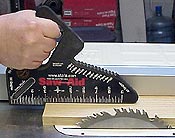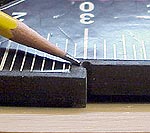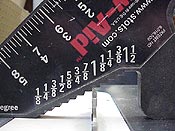 |
The Saw-Aid is a remarkable piece of safety equipment you should not be without.
Click image to enlarge |
Saw-Aid
Safety and Control
Text and Photos by Tom Hintz
Early in life, I learned to appreciate the benefit of ten working fingers. That revelation instilled a life-long desire to preserve their presence and function. While assembling my first woodworking tool, a radial arm saw, I recognized that a machine capable of slicing hardwood could just as easily impede my ability to grasp essential objects like forks and spoons, or the ability to dial 911 to report just such a catastrophe.
Recently, while tabulating the New Woodworker Injury Survey, it became evident that far too many woodworkers were taking unnecessary risks with these precious appendages. I have witnessed experienced woodworkers using their fingers to push stock through a saw that they obviously consider safe but I regard as an unnecessary risk.
Though I have always used push sticks, I have embraced one derivative, the Saw-Aid, from Stots. Of all the push sticks and other safety devices I have purchased or made, the Saw-Aid is by far the best of the bunch.
The first thing you notice about the Saw-Aid is that it looks very rugged. It appears to be made from a glass-filled resin that has no perceptible flex and transmits a very good sense of feel when moving a piece through a table saw. The overall dimensions of the Saw-Aid, 7 15/16-inches tall, 10 5/16-inches long, ½-inch-thick, combine the safety of distance from the blade with the ability to manage relatively small work pieces comfortably.
 |
The circular form at the step helps resist splitting if things get violent.
Click image to enlarge |
The grip handle is formed high enough to keep your hand away from the blade and a considerable portion of the Saw-Aid's mass between your fingers and injury. Its stepped bottom edge provides a firm mechanical grip on a work piece that resists slipping very well. The inside corner of this step features a molded in circular crack-stop that helps resist splitting in the event of contact with a spinning blade.
The seven-inch-long bottom surface ahead of the step seems to grip bare wood very well, providing a solid feel of control while preventing virtually all lifting of the work piece. I also have noticed being able to keep the workpiece firmly against the fence with only slight side or rotational pressure on the Saw-Aid grip.
While Stots was designing the Saw-Aid, they included other useful features. The outer edges have 30, 45 and 90-degree flats that can be used for setting blade angle, or checking cuts on work pieces. A center finder slot and a two-tiered inch scale with large numerals are placed along the bottom edge.
 |
A built-in height setting gauge comes in very handy.
Click image to enlarge |
Turn the Saw-Aid upside down and you have a set of stepped height indicators ranging from 1/8-inch to 1 ½-inches (1/8-inch increments) for setting blade height on your table saw.
I use the Saw-Aid constantly on my table saw and have found no reasonable situation where it does not work. While I have no experience using the Saw-Aid on other machines, that should not automatically preclude those possibilities.
There are few tools that I feel as strongly about as I do the Saw-Aid. I could probably perform many operations on my table saw without the Saw-Aid, but why? I feel no reduction in control or feel at all, but I do recognize the increased margin of safety the Saw-Aid provides.
Nothing can totally eliminate the possibility of injury. The Saw-Aid, when used properly, can make woodworking on a table saw considerably safer. If that is not incentive enough to use this tool, you need to take a hard look at your priorities.
The Saw-Aid is available from many woodworking suppliers with a street price of around $18.
Check Hartville Tool's price! - Click Here
Do you have a comment about this page? - Email Me!
Back to the Tool Reviews List
|
![]()



